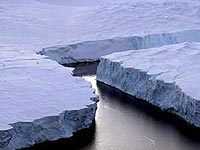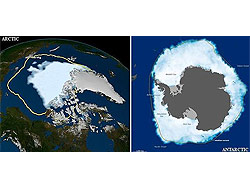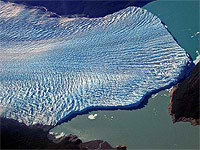La última edición de la revista "Science" incluye un estudio sobre la formación de iceberg que, según los investigadores, "no podrá ayudar al Titanic, pero sí puede ser una simple regla para mejorar la precisión de los modelos predictivos de desprendimientos de las grandes masas de hielo2. El Titanic se hundió en 1912 después de chocar contra un iceberg, y murieron ahogados 1.500 pasajeros.
Los desprendimientos de grandes masas de hiejo de la Antártica y Groenlandia podrían ser una de las causas principales de la elevación del nivel del mar, sobre todo de cara al futuro. Si todo el hielo que albergan se fundiera, los mares subirían más de 60 metros.
Los modelos informáticos para predecir el comportamiento de las placas de hielo ante la elevación de las temperaturas suelen pasar por alto el fenómeno de formación de iceberg porque hasta ahora se trata de mecanismos que no se conocen bien.
"Para que se produzcan, la variable importante, la que explica el mayor número de desprendimientos, es la velocidad de crecimiento de las placas", indican. Una expansión rápida de esas placas se traduce en la formación de grietas, que a su vez dan lugar a iceberg. Según sus observaciones, cuando las grietas se forman más despacio el hielo tiende a mantenerse unido.
"El problema de la formación de iceberg es realmente difícil de describir, porque existen muchísimas variables que lo afectan", explica Richard Alley, de la Universidad de Pennsylvania (Estados Unidos), director de esta investigación. "Cualquiera al que se le haya caído alguna vez el café lo entiende perfectamente. A veces la taza se rompe, otras se vuelca...", dice.
Noticia publicada en Rioja 2 (España)
Enlaces a sitios |
| |
Climbing Magazine Climbing Magazine"s Web site contains more than 30 years of rock and ice climbing news, climber profiles, technical information, and gear reviews. You"ll also find message boards, photo galleries, and classifieds
| Cold Regions Bibliography Between 1999 and 2000, this project was carried out under an Interagency Agreement between the Federal Research Division of the Library of Congress and the U.S. Army Cold Regions Research and Engineering Laboratory (CRREL).
|
Descent into the Ice A tem of "glacionauts" ventures into a labyrinth of unexplored anda hazardous glacier caves on France"s Mont Blanc
| Glacier and Permafrost Hazards in Mountains – GAPHAZ Scientific Working Group of the International Association of Cryospheric Sciences (IACS) and the International Permafrost Association (IPA). Department of Geosciences University of Oslo
|
Glacier hazards The experience and data on glacier disasters in Switzerland has been systematically collected in the past two decades, and historical sources were analyzed.
| Glacier Hazards From Space Glacier hazards represent a continuous threat to human lives and infrastructure in mountain regions.
|
Glacier Hazards in Perú The floods, known in Perú as aluviónes, come with little or no warning and are composed of liquid mud that generally transports large rock boulders and blocks of ice.
| Glaciers and Glacier Hazards Glaciers and Glacier Hazards Glaciers and Ice Sheets and Volcanic Eruptions, USGS/Cascades Volcano Observatory, Vancouver, Washington
|
Glaciers online Glaciers online offers photos and summary explanations concerning glaciers from all over the world. The primary goal of our project is to enrich and stimulate the teaching of Earth Science and Physical Geography, in particular glaciology.. Jürg Alean & Mi
| Global Land Ice Measurements from Space GLIMS (Global Land Ice Measurements from Space) is a project designed to monitor the world"s glaciers primarily using data from optical satellite instruments, such as ASTER (Advanced Spaceborne Thermal Emission and reflection Radiometer).
|











 Imagen: Agencia EFE
Imagen: Agencia EFE





